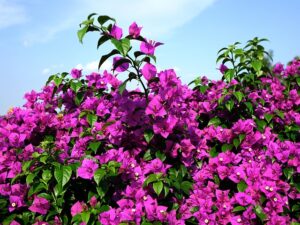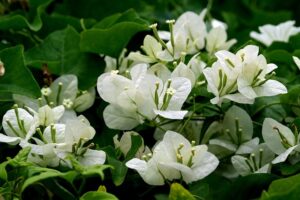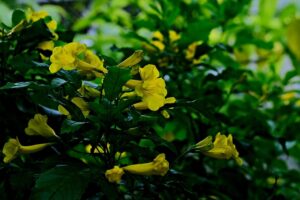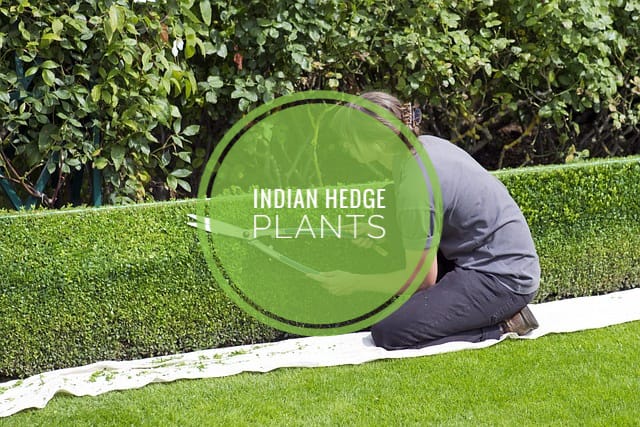Indian hedge plants are essential for gardeners and farmers alike. These plants create natural fences, define garden spaces, provide privacy, and protect farms from animals or intruders. A well-planned hedge not only enhances aesthetics but also improves soil conservation and wind protection.
In India, hedging has been practiced for centuries using both flowering and thorny plants. From small home gardens to large agricultural fields, hedges serve multiple functions while adding greenery and structure. Choosing the right hedge plant depends on your purpose, climate, and soil type.
WHAT IS HEDGING IN INDIAN GARDENS?
Hedging refers to planting dense rows of shrubs or small trees to form natural barriers. These green walls serve multiple purposes:
- Privacy & Aesthetics: Protect homes and gardens while enhancing visual appeal.
- Security: Thorny hedges or dense plants act as barriers against intruders or animals.
- Environmental Benefits: Reduce wind, prevent soil erosion, and attract pollinators.
Hedges are popular in urban gardens, farm boundaries, and public landscapes due to low maintenance, cost-effectiveness, and multifunctional utility.
GARDEN HEDGING (ORNAMENTAL & PRIVACY)
1. Hibiscus (Hibiscus rosa-sinensis)
Hibiscus is a fast-growing hedge with large, colorful flowers that bloom almost year-round. Its dense foliage provides excellent privacy for gardens.
- Native Place: India and Southeast Asia
- Height: 2–3 meters
- Climate Type: Tropical to subtropical
Benefits: Bright blooms, attracts butterflies, easy to shape.
2. Bougainvillea (Bougainvillea glabra)
A thorny evergreen hedge plant, Bougainvillea produces vibrant bracts in pink, purple, and white. Ideal for fences and garden boundaries.
- Native Place: South America (adapted to India)
- Height: 3–5 meters
- Climate Type: Warm, sunny regions
Benefits: Dense coverage, low maintenance, security hedge.

3. Croton / Codiaeum (Codiaeum variegatum)
Croton features variegated foliage in green, yellow, red, and orange. Its compact growth makes it perfect for decorative garden borders.
- Native Place: Southeast Asia
- Height: 1–2 meters
- Climate Type: Tropical, humid
Benefits: Colorful foliage, low-maintenance, suitable for small hedges.
4. Murraya /Orange Jasmine (Murraya paniculata)
An evergreen Indian hedge with fragrant white flowers, Murraya grows compactly and is excellent for formal garden hedges.
- Native Place: India
- Height: 1.5–2.5 meters
- Climate Type: Tropical to subtropical
Benefits: Fragrant blooms, formal shape, low maintenance.
5. Duranta Gold (Duranta repens)
A low-growing hedge with golden-yellow leaves, Duranta Gold adds a decorative touch to garden borders and pathways.
- Native Place: Tropical America
- Height: 1–1.5 meters
- Climate Type: Warm, sunny
Benefits: Decorative foliage, compact growth, suitable for edging.
Garden Hedging (Ornamental & Privacy) TABLE
| Plant Name | Height | Bloom/Foliage | Main Purpose / Benefit |
|---|---|---|---|
| Hibiscus | 2–3 m | Large colorful flowers | Privacy, ornamental, attracts butterflies |
| Bougainvillea | 3–5 m | Colorful bracts | Decorative, dense coverage, security |
| Croton / Codiaeum | 1–2 m | Variegated foliage | Decorative, compact hedge, colorful |
| Murraya / Indian Boxwood | 1.5–2.5 m | Fragrant white flowers | Fragrance, formal shape, privacy |
| Duranta Gold | 1–1.5 m | Golden foliage | Decorative, compact, low-maintenance |
FARM PROTECTION / SECURITY HEDGING
6. Jatropha (Jatropha gossypifolia)
Jatropha is hardy and drought-tolerant, forming a dense hedge that protects farms and boundaries from animals.
- Native Place: Central America
- Height: 2–3 meters
- Climate Type: Tropical, subtropical
Benefits: Security hedge, low maintenance, withstands harsh conditions.
7. Gliricidia (Gliricidia sepium)
Gliricidia is fast-growing with thornless branches, perfect for living fences and shade along farm boundaries.
- Native Place: Central America
- Height: 3–5 meters
- Climate Type: Tropical
Benefits: Nitrogen-fixing, shade provider, quick growth.
8. Acacia / Subabul (Leucaena leucocephala)
Acacia forms thorny, dense hedges, ideal for farm protection and preventing soil erosion on slopes.
- Native Place: Central America
- Height: 3–6 meters
- Climate Type: Warm, arid to semi-arid
Benefits: Security hedge, soil enrichment, drought-tolerant.
9. Bougainvillea (Thorny Varieties)
Thorny Bougainvillea varieties act as both a colorful and protective hedge for farms or homes.
- Native Place: South America (adapted to India)
- Height: 3–5 meters
- Climate Type: Sunny, warm
Benefits: Dense security, low-maintenance, colorful barrier.

10. Tecoma / Yellow Bell (Tecoma stans)
Medium-height hedge with trumpet-shaped yellow flowers. Provides moderate security and aesthetic appeal to farm boundaries.
- Native Place: Central America
- Height: 2–3 meters
- Climate Type: Tropical
Benefits: Attracts pollinators, fast growth, hardy.

Farm Protection / Security Hedging TABLE
| Plant Name | Height | Bloom/Foliage | Main Purpose / Benefit |
|---|---|---|---|
| Jatropha | 2–3 m | Dense green leaves | Security hedge, hardy, drought-tolerant |
| Gliricidia | 3–5 m | Small flowers | Fast-growing, nitrogen-fixing, shade |
| Acacia / Subabul | 3–6 m | Thorny foliage | Protection, soil enrichment, drought-tolerant |
| Bougainvillea (thorny) | 3–5 m | Bright bracts | Security hedge, colorful, low-maintenance |
| Tecoma / Yellow Bell | 2–3 m | Yellow trumpet flowers | Pollinator-friendly, fast growth, hardy |
LANDSCAPING & MIXED UTILITY HEDGES
11. Oleander (Nerium oleander)
A flowering hedge with evergreen foliage and clusters of pink, white, or red flowers. Ideal for landscaping along driveways and gardens. It is widely used as a divider on Indian highways and expressways.
- Native Place: Mediterranean (adapted to India)
- Height: 3–5 meters
- Climate Type: Warm, sunny
Benefits: Long-lasting blooms, privacy, ornamental.
12. Cassia fistula (Golden Shower Tree)
Cassia produces long cascading yellow flowers, suitable for tall hedges on both side of roads and adding color to landscapes.
- Native Place: India
- Height: 3–6 meters
- Climate Type: Tropical, subtropical
Benefits: Ornamental hedge, tall coverage, drought-tolerant.

13. Ixora (Ixora coccinea)
Low-growing, evergreen hedge with dense foliage and red flowers. Perfect for garden borders and decorative edging.
- Native Place: India
- Height: 1–1.5 meters
- Climate Type: Tropical
Benefits: Colorful blooms, compact growth, easy maintenance.
14. Clerodendrum (Clerodendrum splendens)
A fast-growing hedge with glossy green leaves and bright red tubular flowers. Great for mixed landscaping.
- Native Place: India
- Height: 2–3 meters
- Climate Type: Tropical to subtropical
Benefits: Attracts pollinators, dense foliage, decorative flowers.
15. Lantana (Lantana camara)
Lantana is hardy and fast-growing with multicolored flowers, suitable for mixed hedges and roadside landscaping.
- Native Place: Central America
- Height: 1–2 meters
- Climate Type: Tropical, subtropical
Benefits: Low maintenance, attracts butterflies, drought-tolerant.
Landscaping & Mixed Utility TABLE
| Plant Name | Height | Bloom/Foliage | Main Purpose / Benefit |
|---|---|---|---|
| Oleander | 3–5 m | Pink/white/red flowers | Ornamental, privacy, long-lasting blooms |
| Cassia fistula | 3–6 m | Cascading yellow flowers | Tall coverage, ornamental, drought-tolerant |
| Ixora | 1–1.5 m | Red flowers | Decorative borders, compact, flowering |
| Clerodendrum | 2–3 m | Red tubular flowers | Dense foliage, ornamental, attracts pollinators |
| Lantana | 1–2 m | Multicolored flowers | Drought-tolerant, attracts butterflies, decorative |
CARE TIPS FOR HEDGE PLANTS
- Pruning: Trim regularly to encourage dense growth and maintain shape.
- Watering: Young hedges need regular watering; mature plants tolerate dry periods.
- Fertilizing: Apply balanced fertilizers or compost during the growing season.
- Propagation: Most hedges propagate from seeds, cuttings, or layering.
- Pest Control: Check for aphids, mites, and fungal issues; treat promptly with neem oil or mild insecticides.
PROBLEMS & SOLUTIONS
| Problem | Solution |
|---|---|
| Yellow leaves | Improve drainage and reduce overwatering |
| Slow growth | Ensure adequate sunlight and fertilize moderately |
| Pest infestation | Use neem oil or insecticidal soap |
| Fungal infection | Avoid waterlogging; remove affected parts |
| Weak branches | Regular pruning strengthens plants |
USES AND BENEFITS
- Provide privacy and security in homes and farms.
- Serve as windbreaks and reduce soil erosion.
- Enhance aesthetics in gardens and landscaping projects.
- Attract pollinators like bees and butterflies.
- Low-maintenance and cost-effective solution for Indian conditions.
INTERESTING FACTS
- Thorny Bougainvillea and Jatropha are preferred for security hedges.
- Hibiscus and Oleander bloom most of the year in tropical regions.
- Cassia fistula produces golden flowers ideal for festive decorations.
- Duranta attracts butterflies while providing dense coverage.
- Lantana can survive in poor soil and tolerate drought.
FAQs
1. What are the best hedge plants for Indian gardens?
Popular options include Hibiscus, Bougainvillea, Murraya, Duranta, Oleander, and Ixora. Choose based on height and purpose.
2. How often should hedge plants be pruned?
Prune 2–3 times a year to maintain shape, encourage dense growth, and remove dead branches.
3. Can hedge plants grow in pots?
Yes, dwarf varieties like Croton, Duranta Gold, or Ixora are perfect for container hedges.
4. Which hedges bloom year-round in India?
Hibiscus, Bougainvillea, and Oleander provide blooms throughout the year in tropical climates.
5. How do I protect hedges from pests?
Inspect regularly for aphids, mites, and whiteflies. Use neem oil, insecticidal soap or mild organic pesticides.
CONCLUSION
Indian hedge plants are versatile, functional, and visually appealing. Using the right plants for garden hedges, farm protection, or landscaping enhances privacy, aesthetics, and ecological benefits. With minimal care, these plants thrive in Indian conditions, making your garden or farm secure, vibrant, and inviting.
Thanks for reading. Keep growing, keep exploring, and don’t forget to return here at gardeningbud.com for more plants, tips and gardening wisdom.
